Information Systems and ERP: Benefits for Business Operations, LSBM100
VerifiedAdded on 2023/01/12
|7
|2431
|21
Report
AI Summary
This report provides an overview of information systems and Enterprise Resource Planning (ERP) within a business context. It begins by defining information systems and their role in converting raw data into useful information for decision-making. The report then categorizes various information systems, including Data Processing Systems (DPS), Decision Support Systems (DSS), Executive Information Systems (EIS), and Management Information Systems (MIS), detailing their functions and applications. The main body focuses on ERP systems, explaining their purpose in integrating business functions for improved efficiency and transparency. It highlights the benefits of ERP, such as streamlined operations, improved customer support, enhanced financial compliance, and real-time data access, using Marks & Spencer as a real-life business example. The report concludes by summarizing the importance of information systems and ERP in enhancing business performance and resource utilization.
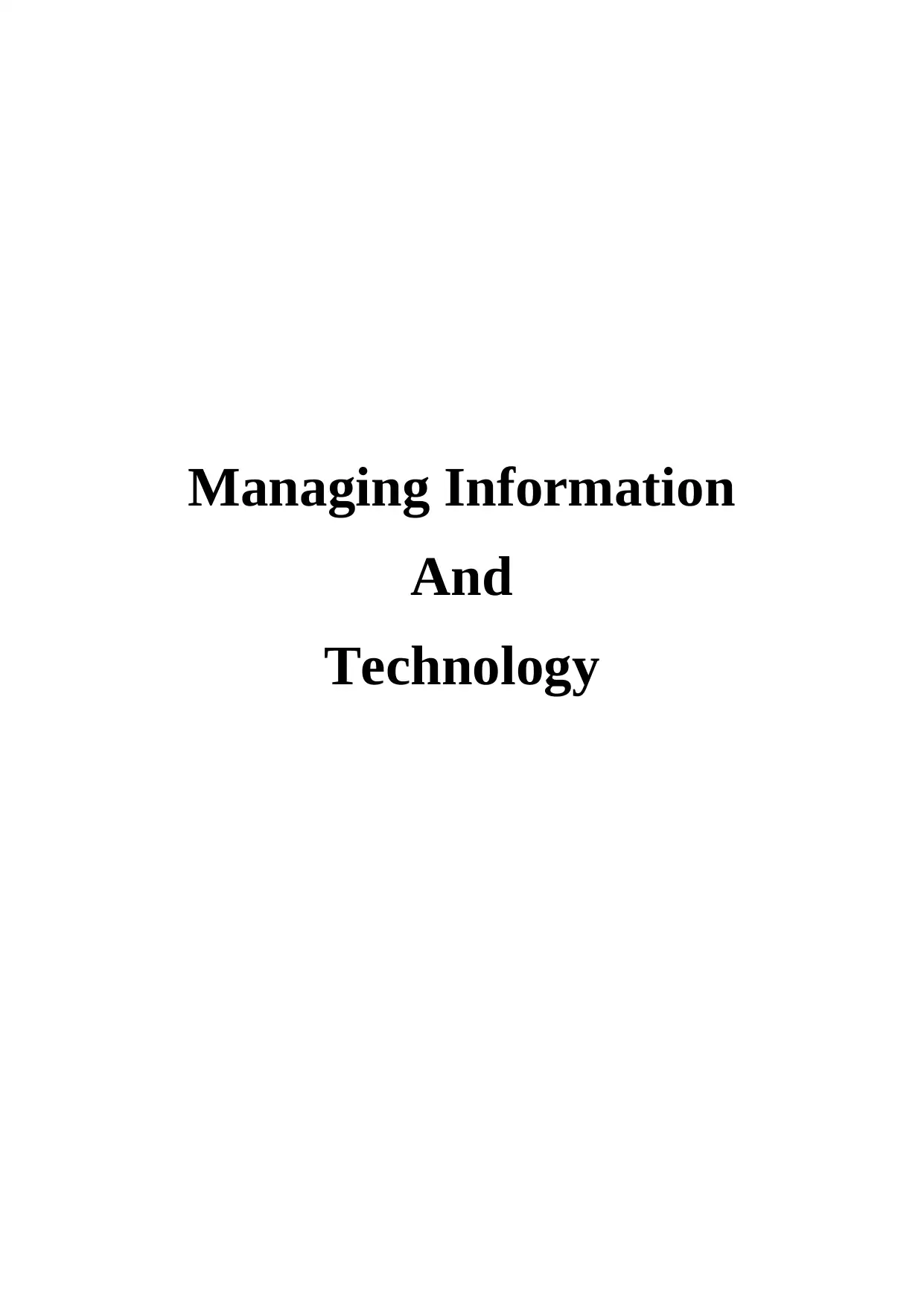
Managing Information
And
Technology
And
Technology
Paraphrase This Document
Need a fresh take? Get an instant paraphrase of this document with our AI Paraphraser
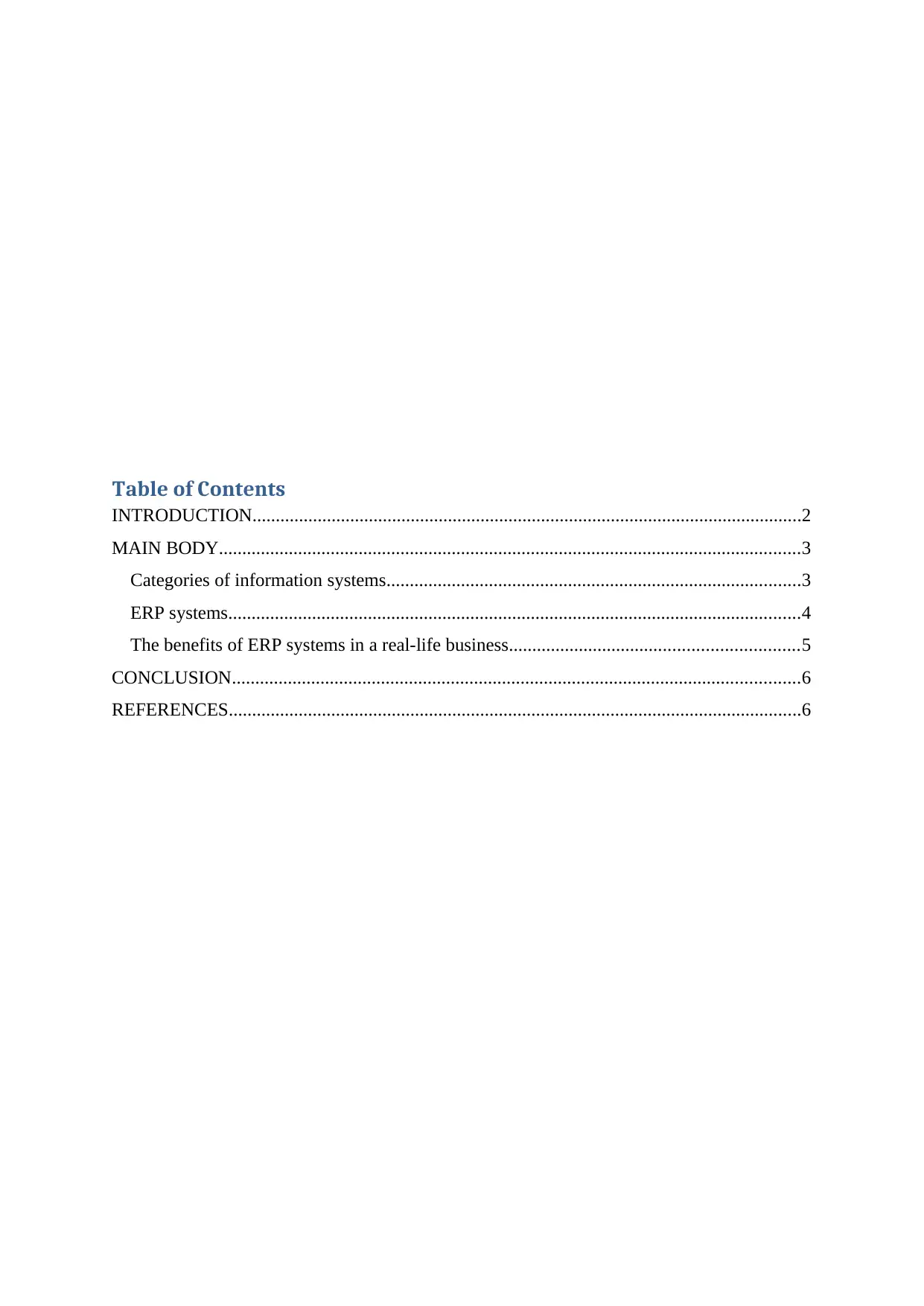
Table of Contents
INTRODUCTION......................................................................................................................2
MAIN BODY.............................................................................................................................3
Categories of information systems.........................................................................................3
ERP systems...........................................................................................................................4
The benefits of ERP systems in a real-life business..............................................................5
CONCLUSION..........................................................................................................................6
REFERENCES...........................................................................................................................6
INTRODUCTION......................................................................................................................2
MAIN BODY.............................................................................................................................3
Categories of information systems.........................................................................................3
ERP systems...........................................................................................................................4
The benefits of ERP systems in a real-life business..............................................................5
CONCLUSION..........................................................................................................................6
REFERENCES...........................................................................................................................6
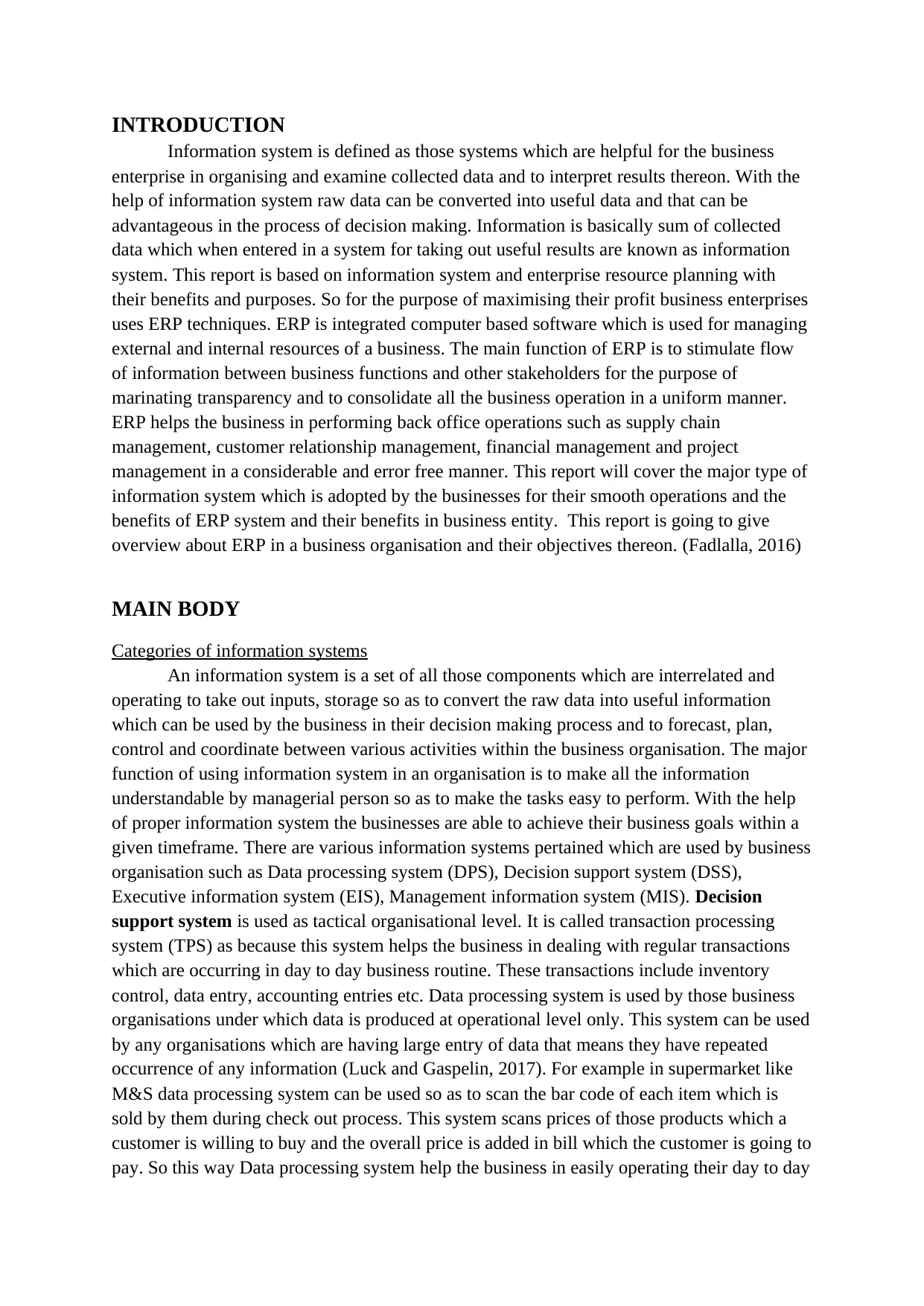
INTRODUCTION
Information system is defined as those systems which are helpful for the business
enterprise in organising and examine collected data and to interpret results thereon. With the
help of information system raw data can be converted into useful data and that can be
advantageous in the process of decision making. Information is basically sum of collected
data which when entered in a system for taking out useful results are known as information
system. This report is based on information system and enterprise resource planning with
their benefits and purposes. So for the purpose of maximising their profit business enterprises
uses ERP techniques. ERP is integrated computer based software which is used for managing
external and internal resources of a business. The main function of ERP is to stimulate flow
of information between business functions and other stakeholders for the purpose of
marinating transparency and to consolidate all the business operation in a uniform manner.
ERP helps the business in performing back office operations such as supply chain
management, customer relationship management, financial management and project
management in a considerable and error free manner. This report will cover the major type of
information system which is adopted by the businesses for their smooth operations and the
benefits of ERP system and their benefits in business entity. This report is going to give
overview about ERP in a business organisation and their objectives thereon. (Fadlalla, 2016)
MAIN BODY
Categories of information systems
An information system is a set of all those components which are interrelated and
operating to take out inputs, storage so as to convert the raw data into useful information
which can be used by the business in their decision making process and to forecast, plan,
control and coordinate between various activities within the business organisation. The major
function of using information system in an organisation is to make all the information
understandable by managerial person so as to make the tasks easy to perform. With the help
of proper information system the businesses are able to achieve their business goals within a
given timeframe. There are various information systems pertained which are used by business
organisation such as Data processing system (DPS), Decision support system (DSS),
Executive information system (EIS), Management information system (MIS). Decision
support system is used as tactical organisational level. It is called transaction processing
system (TPS) as because this system helps the business in dealing with regular transactions
which are occurring in day to day business routine. These transactions include inventory
control, data entry, accounting entries etc. Data processing system is used by those business
organisations under which data is produced at operational level only. This system can be used
by any organisations which are having large entry of data that means they have repeated
occurrence of any information (Luck and Gaspelin, 2017). For example in supermarket like
M&S data processing system can be used so as to scan the bar code of each item which is
sold by them during check out process. This system scans prices of those products which a
customer is willing to buy and the overall price is added in bill which the customer is going to
pay. So this way Data processing system help the business in easily operating their day to day
Information system is defined as those systems which are helpful for the business
enterprise in organising and examine collected data and to interpret results thereon. With the
help of information system raw data can be converted into useful data and that can be
advantageous in the process of decision making. Information is basically sum of collected
data which when entered in a system for taking out useful results are known as information
system. This report is based on information system and enterprise resource planning with
their benefits and purposes. So for the purpose of maximising their profit business enterprises
uses ERP techniques. ERP is integrated computer based software which is used for managing
external and internal resources of a business. The main function of ERP is to stimulate flow
of information between business functions and other stakeholders for the purpose of
marinating transparency and to consolidate all the business operation in a uniform manner.
ERP helps the business in performing back office operations such as supply chain
management, customer relationship management, financial management and project
management in a considerable and error free manner. This report will cover the major type of
information system which is adopted by the businesses for their smooth operations and the
benefits of ERP system and their benefits in business entity. This report is going to give
overview about ERP in a business organisation and their objectives thereon. (Fadlalla, 2016)
MAIN BODY
Categories of information systems
An information system is a set of all those components which are interrelated and
operating to take out inputs, storage so as to convert the raw data into useful information
which can be used by the business in their decision making process and to forecast, plan,
control and coordinate between various activities within the business organisation. The major
function of using information system in an organisation is to make all the information
understandable by managerial person so as to make the tasks easy to perform. With the help
of proper information system the businesses are able to achieve their business goals within a
given timeframe. There are various information systems pertained which are used by business
organisation such as Data processing system (DPS), Decision support system (DSS),
Executive information system (EIS), Management information system (MIS). Decision
support system is used as tactical organisational level. It is called transaction processing
system (TPS) as because this system helps the business in dealing with regular transactions
which are occurring in day to day business routine. These transactions include inventory
control, data entry, accounting entries etc. Data processing system is used by those business
organisations under which data is produced at operational level only. This system can be used
by any organisations which are having large entry of data that means they have repeated
occurrence of any information (Luck and Gaspelin, 2017). For example in supermarket like
M&S data processing system can be used so as to scan the bar code of each item which is
sold by them during check out process. This system scans prices of those products which a
customer is willing to buy and the overall price is added in bill which the customer is going to
pay. So this way Data processing system help the business in easily operating their day to day
⊘ This is a preview!⊘
Do you want full access?
Subscribe today to unlock all pages.

Trusted by 1+ million students worldwide
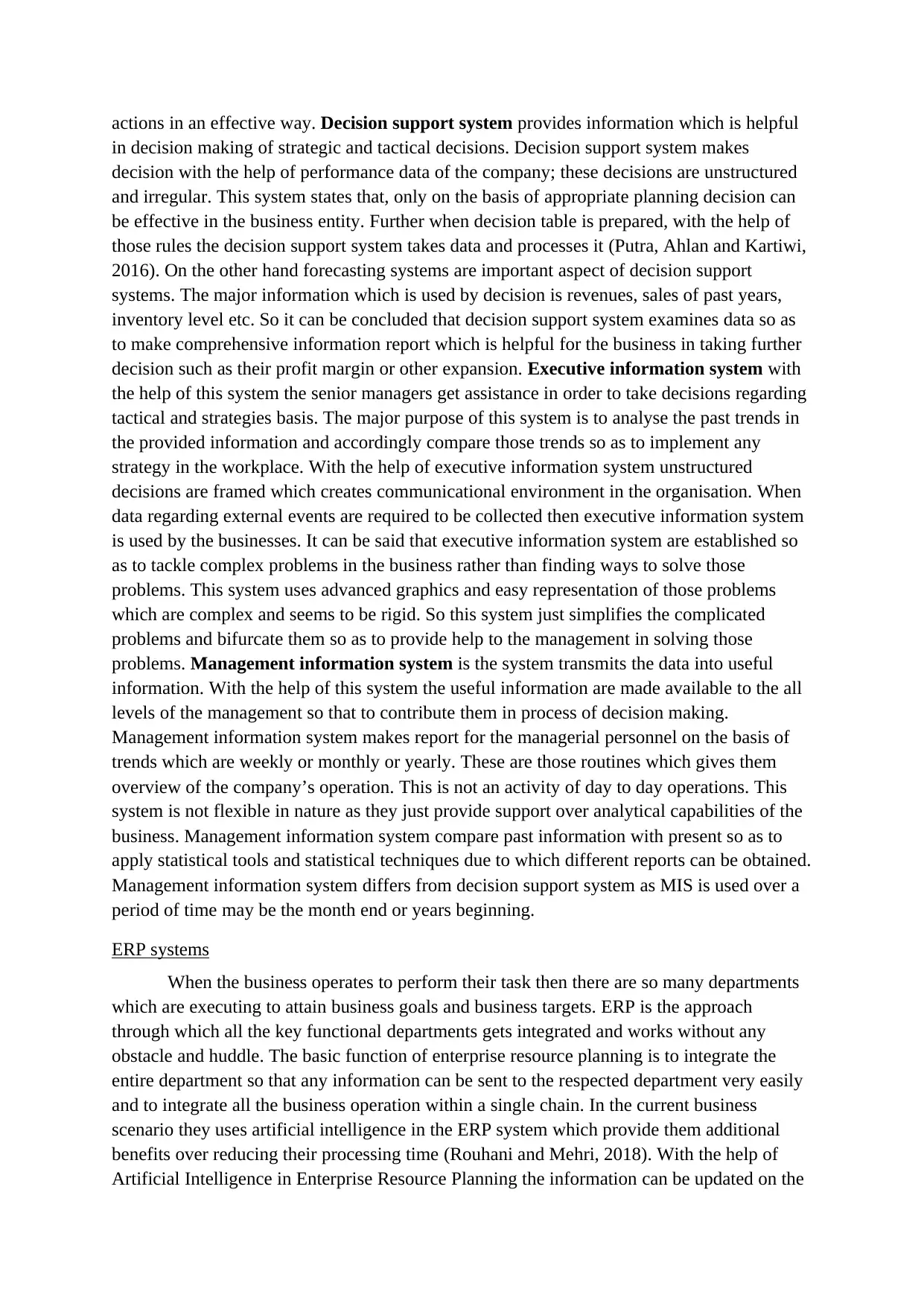
actions in an effective way. Decision support system provides information which is helpful
in decision making of strategic and tactical decisions. Decision support system makes
decision with the help of performance data of the company; these decisions are unstructured
and irregular. This system states that, only on the basis of appropriate planning decision can
be effective in the business entity. Further when decision table is prepared, with the help of
those rules the decision support system takes data and processes it (Putra, Ahlan and Kartiwi,
2016). On the other hand forecasting systems are important aspect of decision support
systems. The major information which is used by decision is revenues, sales of past years,
inventory level etc. So it can be concluded that decision support system examines data so as
to make comprehensive information report which is helpful for the business in taking further
decision such as their profit margin or other expansion. Executive information system with
the help of this system the senior managers get assistance in order to take decisions regarding
tactical and strategies basis. The major purpose of this system is to analyse the past trends in
the provided information and accordingly compare those trends so as to implement any
strategy in the workplace. With the help of executive information system unstructured
decisions are framed which creates communicational environment in the organisation. When
data regarding external events are required to be collected then executive information system
is used by the businesses. It can be said that executive information system are established so
as to tackle complex problems in the business rather than finding ways to solve those
problems. This system uses advanced graphics and easy representation of those problems
which are complex and seems to be rigid. So this system just simplifies the complicated
problems and bifurcate them so as to provide help to the management in solving those
problems. Management information system is the system transmits the data into useful
information. With the help of this system the useful information are made available to the all
levels of the management so that to contribute them in process of decision making.
Management information system makes report for the managerial personnel on the basis of
trends which are weekly or monthly or yearly. These are those routines which gives them
overview of the company’s operation. This is not an activity of day to day operations. This
system is not flexible in nature as they just provide support over analytical capabilities of the
business. Management information system compare past information with present so as to
apply statistical tools and statistical techniques due to which different reports can be obtained.
Management information system differs from decision support system as MIS is used over a
period of time may be the month end or years beginning.
ERP systems
When the business operates to perform their task then there are so many departments
which are executing to attain business goals and business targets. ERP is the approach
through which all the key functional departments gets integrated and works without any
obstacle and huddle. The basic function of enterprise resource planning is to integrate the
entire department so that any information can be sent to the respected department very easily
and to integrate all the business operation within a single chain. In the current business
scenario they uses artificial intelligence in the ERP system which provide them additional
benefits over reducing their processing time (Rouhani and Mehri, 2018). With the help of
Artificial Intelligence in Enterprise Resource Planning the information can be updated on the
in decision making of strategic and tactical decisions. Decision support system makes
decision with the help of performance data of the company; these decisions are unstructured
and irregular. This system states that, only on the basis of appropriate planning decision can
be effective in the business entity. Further when decision table is prepared, with the help of
those rules the decision support system takes data and processes it (Putra, Ahlan and Kartiwi,
2016). On the other hand forecasting systems are important aspect of decision support
systems. The major information which is used by decision is revenues, sales of past years,
inventory level etc. So it can be concluded that decision support system examines data so as
to make comprehensive information report which is helpful for the business in taking further
decision such as their profit margin or other expansion. Executive information system with
the help of this system the senior managers get assistance in order to take decisions regarding
tactical and strategies basis. The major purpose of this system is to analyse the past trends in
the provided information and accordingly compare those trends so as to implement any
strategy in the workplace. With the help of executive information system unstructured
decisions are framed which creates communicational environment in the organisation. When
data regarding external events are required to be collected then executive information system
is used by the businesses. It can be said that executive information system are established so
as to tackle complex problems in the business rather than finding ways to solve those
problems. This system uses advanced graphics and easy representation of those problems
which are complex and seems to be rigid. So this system just simplifies the complicated
problems and bifurcate them so as to provide help to the management in solving those
problems. Management information system is the system transmits the data into useful
information. With the help of this system the useful information are made available to the all
levels of the management so that to contribute them in process of decision making.
Management information system makes report for the managerial personnel on the basis of
trends which are weekly or monthly or yearly. These are those routines which gives them
overview of the company’s operation. This is not an activity of day to day operations. This
system is not flexible in nature as they just provide support over analytical capabilities of the
business. Management information system compare past information with present so as to
apply statistical tools and statistical techniques due to which different reports can be obtained.
Management information system differs from decision support system as MIS is used over a
period of time may be the month end or years beginning.
ERP systems
When the business operates to perform their task then there are so many departments
which are executing to attain business goals and business targets. ERP is the approach
through which all the key functional departments gets integrated and works without any
obstacle and huddle. The basic function of enterprise resource planning is to integrate the
entire department so that any information can be sent to the respected department very easily
and to integrate all the business operation within a single chain. In the current business
scenario they uses artificial intelligence in the ERP system which provide them additional
benefits over reducing their processing time (Rouhani and Mehri, 2018). With the help of
Artificial Intelligence in Enterprise Resource Planning the information can be updated on the
Paraphrase This Document
Need a fresh take? Get an instant paraphrase of this document with our AI Paraphraser
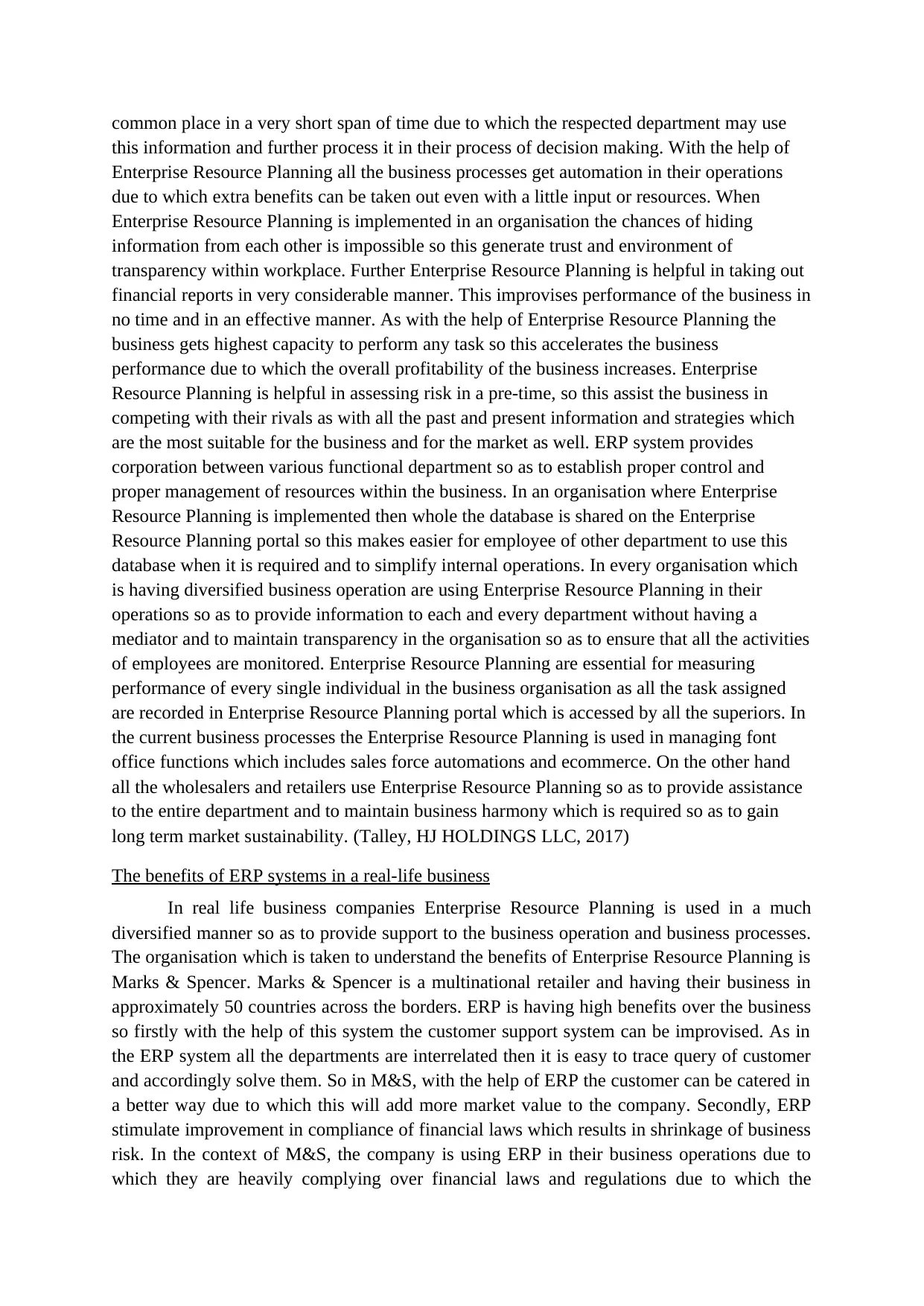
common place in a very short span of time due to which the respected department may use
this information and further process it in their process of decision making. With the help of
Enterprise Resource Planning all the business processes get automation in their operations
due to which extra benefits can be taken out even with a little input or resources. When
Enterprise Resource Planning is implemented in an organisation the chances of hiding
information from each other is impossible so this generate trust and environment of
transparency within workplace. Further Enterprise Resource Planning is helpful in taking out
financial reports in very considerable manner. This improvises performance of the business in
no time and in an effective manner. As with the help of Enterprise Resource Planning the
business gets highest capacity to perform any task so this accelerates the business
performance due to which the overall profitability of the business increases. Enterprise
Resource Planning is helpful in assessing risk in a pre-time, so this assist the business in
competing with their rivals as with all the past and present information and strategies which
are the most suitable for the business and for the market as well. ERP system provides
corporation between various functional department so as to establish proper control and
proper management of resources within the business. In an organisation where Enterprise
Resource Planning is implemented then whole the database is shared on the Enterprise
Resource Planning portal so this makes easier for employee of other department to use this
database when it is required and to simplify internal operations. In every organisation which
is having diversified business operation are using Enterprise Resource Planning in their
operations so as to provide information to each and every department without having a
mediator and to maintain transparency in the organisation so as to ensure that all the activities
of employees are monitored. Enterprise Resource Planning are essential for measuring
performance of every single individual in the business organisation as all the task assigned
are recorded in Enterprise Resource Planning portal which is accessed by all the superiors. In
the current business processes the Enterprise Resource Planning is used in managing font
office functions which includes sales force automations and ecommerce. On the other hand
all the wholesalers and retailers use Enterprise Resource Planning so as to provide assistance
to the entire department and to maintain business harmony which is required so as to gain
long term market sustainability. (Talley, HJ HOLDINGS LLC, 2017)
The benefits of ERP systems in a real-life business
In real life business companies Enterprise Resource Planning is used in a much
diversified manner so as to provide support to the business operation and business processes.
The organisation which is taken to understand the benefits of Enterprise Resource Planning is
Marks & Spencer. Marks & Spencer is a multinational retailer and having their business in
approximately 50 countries across the borders. ERP is having high benefits over the business
so firstly with the help of this system the customer support system can be improvised. As in
the ERP system all the departments are interrelated then it is easy to trace query of customer
and accordingly solve them. So in M&S, with the help of ERP the customer can be catered in
a better way due to which this will add more market value to the company. Secondly, ERP
stimulate improvement in compliance of financial laws which results in shrinkage of business
risk. In the context of M&S, the company is using ERP in their business operations due to
which they are heavily complying over financial laws and regulations due to which the
this information and further process it in their process of decision making. With the help of
Enterprise Resource Planning all the business processes get automation in their operations
due to which extra benefits can be taken out even with a little input or resources. When
Enterprise Resource Planning is implemented in an organisation the chances of hiding
information from each other is impossible so this generate trust and environment of
transparency within workplace. Further Enterprise Resource Planning is helpful in taking out
financial reports in very considerable manner. This improvises performance of the business in
no time and in an effective manner. As with the help of Enterprise Resource Planning the
business gets highest capacity to perform any task so this accelerates the business
performance due to which the overall profitability of the business increases. Enterprise
Resource Planning is helpful in assessing risk in a pre-time, so this assist the business in
competing with their rivals as with all the past and present information and strategies which
are the most suitable for the business and for the market as well. ERP system provides
corporation between various functional department so as to establish proper control and
proper management of resources within the business. In an organisation where Enterprise
Resource Planning is implemented then whole the database is shared on the Enterprise
Resource Planning portal so this makes easier for employee of other department to use this
database when it is required and to simplify internal operations. In every organisation which
is having diversified business operation are using Enterprise Resource Planning in their
operations so as to provide information to each and every department without having a
mediator and to maintain transparency in the organisation so as to ensure that all the activities
of employees are monitored. Enterprise Resource Planning are essential for measuring
performance of every single individual in the business organisation as all the task assigned
are recorded in Enterprise Resource Planning portal which is accessed by all the superiors. In
the current business processes the Enterprise Resource Planning is used in managing font
office functions which includes sales force automations and ecommerce. On the other hand
all the wholesalers and retailers use Enterprise Resource Planning so as to provide assistance
to the entire department and to maintain business harmony which is required so as to gain
long term market sustainability. (Talley, HJ HOLDINGS LLC, 2017)
The benefits of ERP systems in a real-life business
In real life business companies Enterprise Resource Planning is used in a much
diversified manner so as to provide support to the business operation and business processes.
The organisation which is taken to understand the benefits of Enterprise Resource Planning is
Marks & Spencer. Marks & Spencer is a multinational retailer and having their business in
approximately 50 countries across the borders. ERP is having high benefits over the business
so firstly with the help of this system the customer support system can be improvised. As in
the ERP system all the departments are interrelated then it is easy to trace query of customer
and accordingly solve them. So in M&S, with the help of ERP the customer can be catered in
a better way due to which this will add more market value to the company. Secondly, ERP
stimulate improvement in compliance of financial laws which results in shrinkage of business
risk. In the context of M&S, the company is using ERP in their business operations due to
which they are heavily complying over financial laws and regulations due to which the
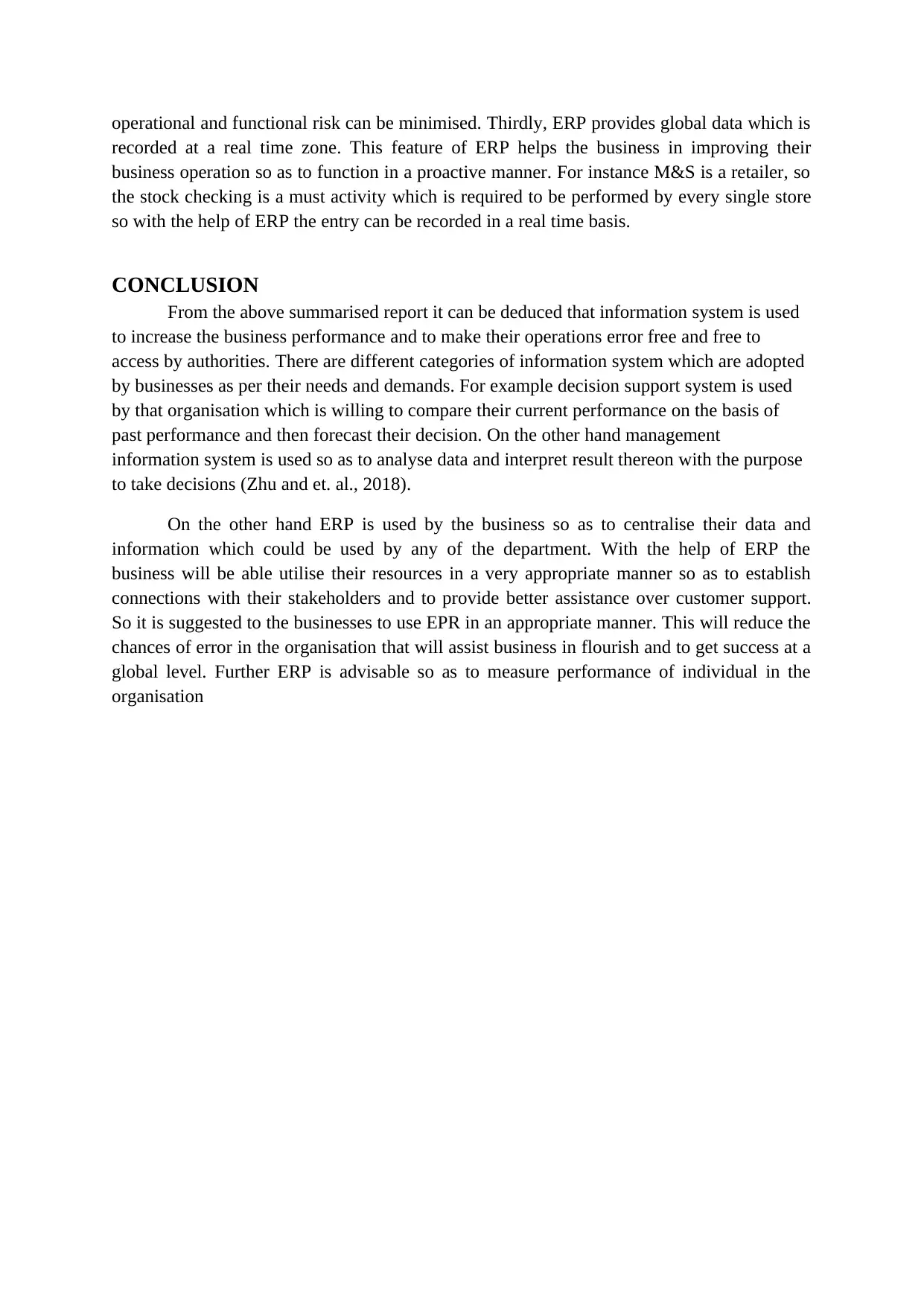
operational and functional risk can be minimised. Thirdly, ERP provides global data which is
recorded at a real time zone. This feature of ERP helps the business in improving their
business operation so as to function in a proactive manner. For instance M&S is a retailer, so
the stock checking is a must activity which is required to be performed by every single store
so with the help of ERP the entry can be recorded in a real time basis.
CONCLUSION
From the above summarised report it can be deduced that information system is used
to increase the business performance and to make their operations error free and free to
access by authorities. There are different categories of information system which are adopted
by businesses as per their needs and demands. For example decision support system is used
by that organisation which is willing to compare their current performance on the basis of
past performance and then forecast their decision. On the other hand management
information system is used so as to analyse data and interpret result thereon with the purpose
to take decisions (Zhu and et. al., 2018).
On the other hand ERP is used by the business so as to centralise their data and
information which could be used by any of the department. With the help of ERP the
business will be able utilise their resources in a very appropriate manner so as to establish
connections with their stakeholders and to provide better assistance over customer support.
So it is suggested to the businesses to use EPR in an appropriate manner. This will reduce the
chances of error in the organisation that will assist business in flourish and to get success at a
global level. Further ERP is advisable so as to measure performance of individual in the
organisation
recorded at a real time zone. This feature of ERP helps the business in improving their
business operation so as to function in a proactive manner. For instance M&S is a retailer, so
the stock checking is a must activity which is required to be performed by every single store
so with the help of ERP the entry can be recorded in a real time basis.
CONCLUSION
From the above summarised report it can be deduced that information system is used
to increase the business performance and to make their operations error free and free to
access by authorities. There are different categories of information system which are adopted
by businesses as per their needs and demands. For example decision support system is used
by that organisation which is willing to compare their current performance on the basis of
past performance and then forecast their decision. On the other hand management
information system is used so as to analyse data and interpret result thereon with the purpose
to take decisions (Zhu and et. al., 2018).
On the other hand ERP is used by the business so as to centralise their data and
information which could be used by any of the department. With the help of ERP the
business will be able utilise their resources in a very appropriate manner so as to establish
connections with their stakeholders and to provide better assistance over customer support.
So it is suggested to the businesses to use EPR in an appropriate manner. This will reduce the
chances of error in the organisation that will assist business in flourish and to get success at a
global level. Further ERP is advisable so as to measure performance of individual in the
organisation
⊘ This is a preview!⊘
Do you want full access?
Subscribe today to unlock all pages.

Trusted by 1+ million students worldwide
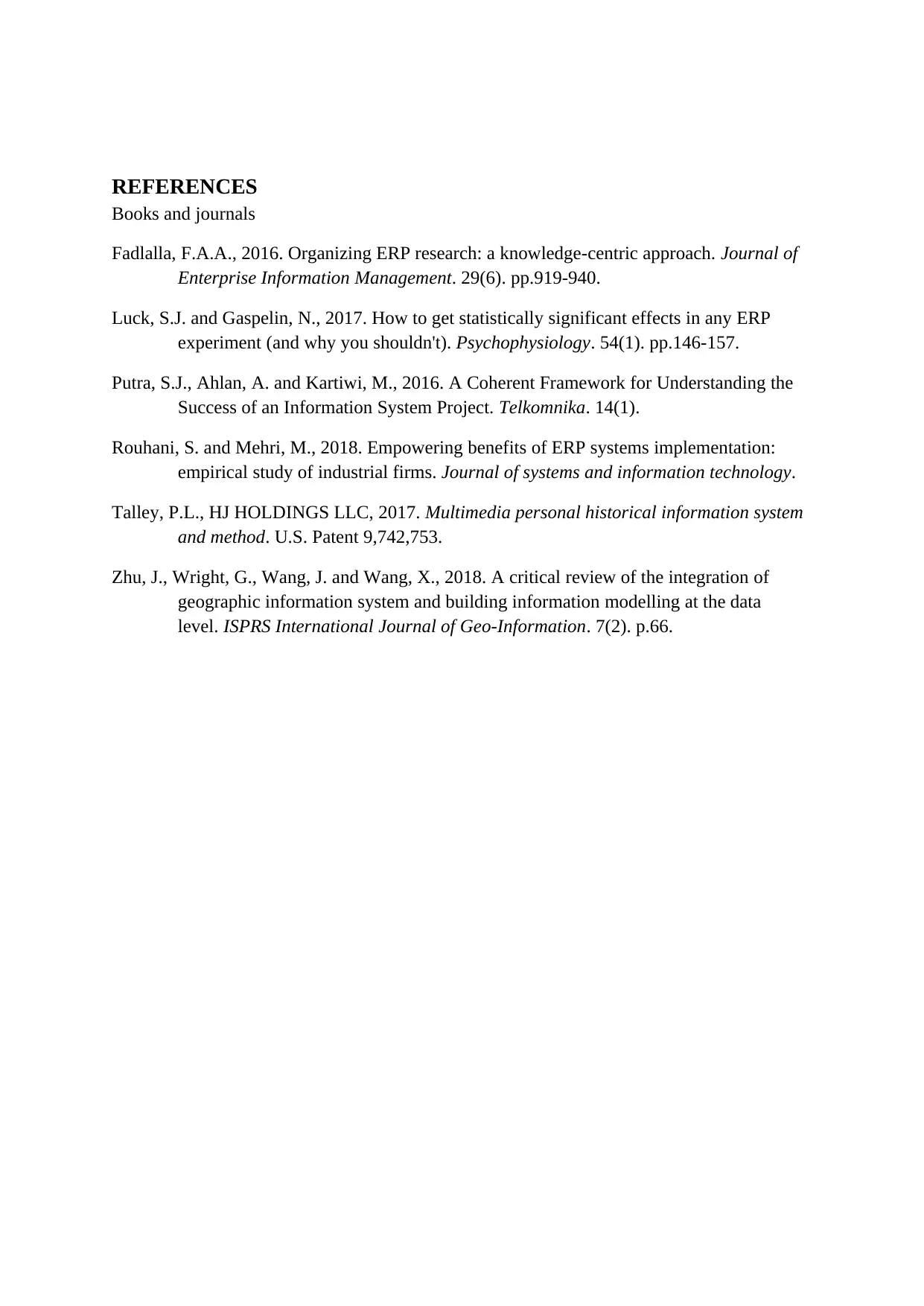
REFERENCES
Books and journals
Fadlalla, F.A.A., 2016. Organizing ERP research: a knowledge-centric approach. Journal of
Enterprise Information Management. 29(6). pp.919-940.
Luck, S.J. and Gaspelin, N., 2017. How to get statistically significant effects in any ERP
experiment (and why you shouldn't). Psychophysiology. 54(1). pp.146-157.
Putra, S.J., Ahlan, A. and Kartiwi, M., 2016. A Coherent Framework for Understanding the
Success of an Information System Project. Telkomnika. 14(1).
Rouhani, S. and Mehri, M., 2018. Empowering benefits of ERP systems implementation:
empirical study of industrial firms. Journal of systems and information technology.
Talley, P.L., HJ HOLDINGS LLC, 2017. Multimedia personal historical information system
and method. U.S. Patent 9,742,753.
Zhu, J., Wright, G., Wang, J. and Wang, X., 2018. A critical review of the integration of
geographic information system and building information modelling at the data
level. ISPRS International Journal of Geo-Information. 7(2). p.66.
Books and journals
Fadlalla, F.A.A., 2016. Organizing ERP research: a knowledge-centric approach. Journal of
Enterprise Information Management. 29(6). pp.919-940.
Luck, S.J. and Gaspelin, N., 2017. How to get statistically significant effects in any ERP
experiment (and why you shouldn't). Psychophysiology. 54(1). pp.146-157.
Putra, S.J., Ahlan, A. and Kartiwi, M., 2016. A Coherent Framework for Understanding the
Success of an Information System Project. Telkomnika. 14(1).
Rouhani, S. and Mehri, M., 2018. Empowering benefits of ERP systems implementation:
empirical study of industrial firms. Journal of systems and information technology.
Talley, P.L., HJ HOLDINGS LLC, 2017. Multimedia personal historical information system
and method. U.S. Patent 9,742,753.
Zhu, J., Wright, G., Wang, J. and Wang, X., 2018. A critical review of the integration of
geographic information system and building information modelling at the data
level. ISPRS International Journal of Geo-Information. 7(2). p.66.
1 out of 7
Related Documents
Your All-in-One AI-Powered Toolkit for Academic Success.
+13062052269
info@desklib.com
Available 24*7 on WhatsApp / Email
![[object Object]](/_next/static/media/star-bottom.7253800d.svg)
Unlock your academic potential
Copyright © 2020–2025 A2Z Services. All Rights Reserved. Developed and managed by ZUCOL.




